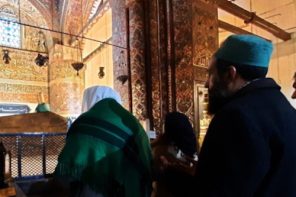In Moving by the Spirit: Pentecostal Social Life on the Zambian Copperbelt, Naomi Haynes provides a compelling ethnographic study of the centrality of Pentecostal Christianity in contemporary Zambia. In doing so she attempts to complicate the narrative of Pentecostalism as an individualising religion focused on personal salvation and success, instead highlighting the social productivity of Pentecostal theology and church communities. This formulation offers a more complex and nuanced vision of the Pentecostal movement. Haynes’ attention to certain socially productive elements of Pentecostalism allows her to dig deep into her ethnographic material and to detail what animates the everyday, interpersonal relationships at the core of Pentecostal Christian communities on the Zambian Copperbelt.
In the introduction, Haynes outlines her concept of “moving by the spirit” as a way to interpret the motivating values, desires, and ambitions of Pentecostal Christians. On the Copperbelt, as we learn through various ethnographic vignettes, “moving by the spirit” is recognized in conspicuous and material ways, both big and small. While Haynes notes that major events such as marriage ceremonies and securing steady employment are important in establishing one’s position, she tends to focus on smaller and more intricate interactions that index the everyday ways people realize “moving” in a positive direction. These include improving one’s household furniture, purchasing an upright refrigerator, traveling to church meetings in taxis instead of shared public transportation, and membership in local chilimba credit associations. Haynes uses the eight thematic chapters of the book to unpack how these material signs of spiritual movement are carefully managed by church members and religious leaders. She argues that a key tension emerges through Pentecostals’ pursuits of economic and spiritual movement – one between charisma and prosperity.
In Copperbelt Pentecostalism, charisma and charismatic authority must always outrank prosperity, lest the pursuit of wealth become an end in itself.
Haynes uses this tension between charisma and prosperity as a lens through which to examine questions of gender, value, debt, and schism in the Pentecostal church. In chapter one, Haynes positions contemporary Pentecostalism on the Copperbelt within a longer history of cycles of “boom and bust.” She argues that a cyclical nature of prosperity and poverty informs the characteristics of Pentecostalism in the extractive mining economy of the Copperbelt. Drawing on Jane Guyer’s work on marginal gains in Atlantic African economies (Guyer 2004), Haynes highlights how “moving by the spirit” is often understood through small, gradual improvements in people’s everyday material conditions. This raises interesting questions for future studies of similar “boom and bust” economies in other geographic sites, and the relationships between religiosity and value they may engender. Chapter two provides ethnographic insight into how individuals cultivate the types of interpersonal relationship it takes to “move” in a positive direction, and how these relationships are typically built around asymmetries of wealth and status between church members. Haynes describes these asymmetric relationships as necessarily comprised of “both stratification and sociality – of economic difference and of relationships that span that difference” (pp. 47).
Chapters three and four examine how church members cultivate relationships with pastors and church leaders and the challenging work of negotiating money and other gifts publicly given by congregants to religious leaders. These gifts, or “seed offerings,” are meant to facilitate positive “breakthroughs” in the personal lives of church goers. But Haynes also documents the tensions these gifts create by challenging the egalitarian and democratic promises of Pentecostalism to bestow the gifts of God equally among believers.
She shows how this form of conspicuous gift giving can work to sow suspicion among Pentecostals that all congregants, despite economic disparities, receive the same favor from pastors and church leadership.
In chapters five through eight Haynes returns to the tension between prosperity and charisma to take up issues of gender, hierarchy, and schism. In her discussion of gender, Haynes offers an insightful analysis that moves beyond Pentecostalism as either progressive in its empowerment of women via their inclusion in church leadership, or conservative in its promotion of traditional gender roles and norms. Instead, Haynes considers gender through the lens of charisma and prosperity. She convincingly demonstrates that women most often come into positions of power in the Pentecostal church not through charismatic preaching or prophecy, as do their male colleagues, but by demonstrating how God’s gifts have created prosperity in their own lives. Gendered roles, Haynes argues, are yet another site of contestation between charisma and prosperity and a powerful way in which prosperity is kept subordinate to charisma in Pentecostal social life. This is an important contribution to the study of gender in the anthropology of Christianity and provides a model for considering the Pentecostal movement, and its myriad social and cultural implications, outside of a binary progressive/normative framework.

References:
Ferguson, James. 1999. Expectations of Modernity: Myths and Meanings of Urban Life on the Zambian Copperbelt. Berkeley: University of California Press
Guyer, Jane. 2004. Marginal Gains: Monetary transactions in Atlantic Africa. Chicago: University of Chicago Press.
Naomi Hynes (2017). Moving By the Spirit: Pentecostal Social Life in the Zambian Copperbelt. University of California Press.
Werbner, Richard P. 1984. The Manchester School in south-central Africa. Annual Review of Anthropology 13: 157-85.









